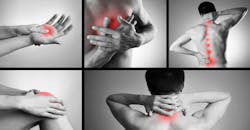Sore Losers: Musculoskeletal Disorders Are Costing Billions
According to the Liberty Mutual Workplace Safety Index, the leading cause of all non-fatal injuries in American workplaces are overexertion injuries, types of musculoskeletal disorders (MSDs). These accounted for nearly ¼ of all non-fatal workplace injuries, costing $15 billion in medical fees and indemnity payments.
As high as this amount is, the indirect costs might make you make extra sure you lift with your legs, not your back. They could amount to up to to 4.5 times the direct costs, or about $68 billion. These include lost production time, spoiled product, training new employees, overhead costs, legal fees, higher insurance costs and more.
So how do you reduce your company's risk to contributing to this exorbitant amount?
There are MSD risk assessment tools such as ACGIH’s threshold limit value (TLV) for hand-activity level (HAL), the NIOSH Lifting Equation and the Snook & Ciriello psychophysical guidelines for pushing, pulling and carrying activities.
"All of these tools are meaningful and valid, yet most were developed in the 1980s and 1990s" says Blake McGowan, certified professional ergonomist. "More recently, there have been several excellent epidemiological studies that have added to our understanding of the risk factors associated with MSDs."
McGowan explains that a 1997 NIOSH review determined this provided evidence of a causal relationship between several workplace risk factors and MSDs.
"The primary biomechanical risk factors included repetitive motion, excessive force, awkward postures, sustained postures and prolonged sitting and standing," he says.
Here's the summary of the risk factors:
Neck: Risk factors include awkward neck postures (both repetitive or sustained) and general heavy physical work, like forceful exertions and frequent lifting.
Low back: The risk factors include heavy physical work, such as heavy lifting and forceful exertions, repetitive lifting, excessive reaching, stooping and prolonged standing. Recently, Garg et al. (2014) showed a statistically significant exposure-response relationship between the NIOSH lifting equation peak lifting force (PLI) and the peak composite lifting index (PCLI), and low back pain.
Upper limb: Heavy physical work, forceful exertions, awkward postures, repetition and prolonged computer mouse use contribute to upper limb injuries (shoulder, arm, elbow, forearm, wrist and hand), such as tendinitis, lateral epicondylitis and carpal tunnel syndrome (CTS).
Shoulder: Physically strenuous work, heavy pushing and pulling, and repetitive tool use can influence shoulder injuries. Recently, Hoozemans et al. (2014) summarized high-quality cohort studies and showed there is strong evidence that pushing and pulling are related to upper-extremity symptoms, specifically shoulder symptoms.
Elbow/forearm: Risk factors include sustained gripping postures, forceful exertions, repetitive arm and wrist motions, prolonged computer mouse use and other repetitive work.
Wrist/hand: Risk factors include frequent awkward postures such as wrist flexion and extension, forceful exertions, heavy physical work, and prolonged computer mouse use. Recently, in a large multi-site, cross-sectional cohort study, Fan et al. (2015) found a strong dose-response relationship between jobs requiring high hand force and CTS, while wrist posture or repetition on their own were not significant contributors to CTS. Also, Kapellusch et al. (2014) demonstrated the ACGIH TLV for HAL is a strong predictor of CTS, as well as peak force and the hand activity level.
Lower limb: Two primary biomechanical risk factors are repetitive stair climbing and repetitive heavy lifting. Other risk factors for MSDs, such as meniscectomy, are prolonged kneeling or squatting.
A risk factor study by Gallagher and Heberger also found that tasks that expose individuals to:
- Low force (at either a low repetition or high repetition) only nominally impact the risk of joint injury.
- High force and low repetition pose a low risk of joint injury, and
- High force and high repetition significantly increase the risk of joint injury.
McGowan surmises that "awkward posture and high repetition will increase the risk of joint injury, while neutral posture and high repetition will have little impact on injury."
If you've ever handled material in your life, this seems like common sense stuff. But somedays we're all guilty of doing work quick instead of doing it right.
So let this serve as a friendly reminder that neglecting proper ergonomic techniques will not only cost American manufacturing companies billions, but you'll also miss out on playing with your kids, fixing up that old Mustang in the garage, and even your intramural bare knuckle boxing league.
"So, make sure to use a valid MSD risk assessment tool that covers all of the main body areas, that focuses on forceful exertions and awkward postures, and that also allows assessment of sustained work and repetition," McGowan says.
Read more on this topic at our sister publication, EHSToday.com.
About the Author
John Hitch
Editor, Fleet Maintenance
John Hitch, based out of Cleveland, Ohio, is the editor of Fleet Maintenance, a B2B magazine that addresses the service needs for all commercial vehicle makes and models (Classes 1-8), ranging from shop management strategies to the latest tools to enhance uptime.
He previously wrote about equipment and fleet operations and management for FleetOwner, and prior to that, manufacturing and advanced technology for IndustryWeek and New Equipment Digest. He is an award-winning journalist and former sonar technician aboard a nuclear-powered submarine where he served honorably aboard the fast-attack submarine USS Oklahoma City (SSN-723).



